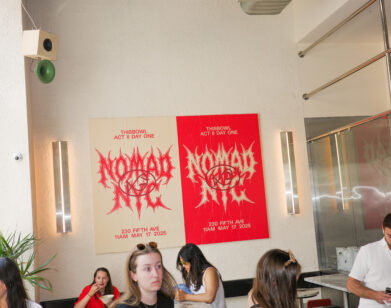Blanca Li and Maria Alexandrova, In Harmony
PHOTOS: HANS NEUMANN. STYLING: MARINA MUÑOZ/LALALAND ARTISTS. HAIR: DAVID COLVIN FOR BUMBLE AND BUMBLE. MAKEUP: ALLIE SMITH/BRIDGE USING GIORGIO ARMANI BEAUTY. STYLING ASSISTANT: ELLEN PURTILL.
“I wanted to do a show that is a celebration of women, of femininity,” explains dancer and choreographer Blanca Li of her piece Goddesses and Demonesses. “I wanted to talk about women in dance—about us as females in a profession that is very specific—but I also wanted to talk about women choreographers and women in general that live today in a world where you have to be a superhero,” she continues. “A professional, competitive, beautiful, smart. There is so much pressure, but still women are not respected 100 percent.”
Tonight, Li and her dance partner, Russian ballet star Maria Alexandrova, will begin a three-night run of Goddesses and Demonesses at the New York City Center. Though it is by no means a narrative piece, it is in part inspired by stories from ancient mythology—Greek goddesses and the idea of the woman as “the center of the world, the center of creation, [and] the mother of all life.”
“I don’t want to focus on one story,” says Li. “It’s a journey in a magic world, like a dream almost.”
Li has a long history with the fashion world—outside of collaborating with designers on costumes for her dance pieces, she has choreographed fashion shows and danced in campaigns. For Goddesses and Demonesses, Stella McCartney, Azzedine Alaïa, Jean-Paul Gaultier, and Sophie Theallet all created custom costumes. “I love costumes in dance, I think it’s very important,” Li tells us. “The clothes for dancing not only make you feel like somebody else, but it makes you move in a different way.” In some instances, the costumes inspire the choreography. Li first saw the red Alaïa dress she wears in Goddesses and Demonesses, for example, on the runway. “I looked at the dress and I was like, ‘Wow,'” she recalls. “I wanted to create a dance for this dress … I could talk about so many things with it.”
EMMA BROWN: How did you two first meet?
BLANCA LI: We met in Moscow the first time, but it was through the director of the Paris Opera, Brigitte Lefèvre. I talked to her about the show I wanted to do, and I asked her who could be the women that would dance with me. I was looking for a woman that would be very different from me—the opposite of me—but at the same time, somebody that could dance with me. Brigitte knew all the classical dancers, she’d worked for 20 years as the director of the Paris Opera, and she told me, “I think that this dancer at the Bolshoi Ballet, Maria Alexandrova, could really work with you.” She knew my energy, my spirit, and my soul. She put us in contact, and I came to visit Maria in Moscow the first time and we met. We spent some hours in the studio and we had a good feeling, so we decided to do this adventure together.
BROWN: So you knew you wanted a classical ballerina?
LI: Yes, because I wanted somebody that was very, very, very different from me. I wanted to talk about dance with another woman, but also talk about the fact that we are two women that have lived all our lives through dance—my life has been dance since I was little, Maria’s life has been dance since she was little, but we live in a totally different context. I was born in Spain, I came to study in New York, and then I was living in Berlin, in France. I started in gymnastics and then I did modern dance. I worked with hip-hop dancers, with modern dancers, with flamenco, with circus people. But still dance was always my life. And Maria was born in Moscow; she grew up in classical dance. She worked for 19 years at the Bolshoi Ballet, which is the temple of classical ballet. I thought it was very interesting for the two of us that have such different lives, but we have one thing in common, which is the love and the passion we have for dance, to share the stage. And we could tell a story about our life and what it is to be a dancer as a woman through a different way of expressing through dance.
MARIA ALEXANDROVA: I’m very adventurous, especially in the professional sense. It was very easy for me to take Blanca up on that offer. Brigitte [Lefèvre] called me and told me that there is this person named Blanca, and in general, I’m always looking forward to learning new things. I never know what’s inside, and I just enjoy the moment.
BROWN: What’s it like when you meet another dancer and dance together for the first time?
LI: With dancers, we are all the time dancing with somebody else. It happens often that you meet a new dancer or you have a new partner, so we are very relaxed about this. But what is true is that sometimes, when you dance with some people, there is not the right feeling. And you know it’s not going to happen the way you want, even though you can do it. But, with Maria, what happened was that from the first moment, when we started to dance, we had a joy—we started to laugh. That was very positive.
BROWN: Have you ever had an experience where you really admired someone’s dancing, but when you danced together, it just didn’t click?
LI: Unfortunately, yes. It’s very frustrating because you don’t understand why it’s not happening. Of course I work as a dancer, but I also work as a choreographer with couples that have a lot of tension between them, and as dancer and as a choreographer, being in this situation is very difficult. You see the energy doesn’t flow, and it’s very tense. I’m sure Maria has had this experience also.
ALEXANDROVA: I experience it all the time.
LI: From my own experiences, when this happens, it is a problem of ego. I think one of the two don’t let go—they want to have the power over the other person. And then it’s impossible to dance. It’s like making love. It has to be a harmony; it has to be about two bodies. When one is like, “I am the good one,” it doesn’t work.
ALEXANDROVA: I agree. Artistic people, they are very free, but at the same time, there’s a lot of ego going on.
LI: This is the other very important thing with Maria, we are two are very strong personalities, but there was never an ego problem, and the only way we can do this show together is if one is in the service of the other, doing everything we can to make it happen. I had to find that person who was ready to live this experience of two women together on stage, but without the attitude of, “I’m better” or “You’re better.” We are two together.
BROWN: Do you find there’s a different dynamic dancing with men versus dancing with women, and do you prefer one to the other?
LI: I don’t prefer one or the other. But I think it is very different. What is very interesting is we hardly ever dance with another woman. We always dance with men. We dance with women in groups, but it is very rare that you have a partner that is a woman. The dance world is very macho—woman, boy, always couples, and it’s very standardized.
ALEXANDROVA: In general, this was my first experience dancing with a woman. I like to dance with very strong men, and I have to say that for me it wasn’t really different in the sense that Blanca is so strong. I felt like I just had a strong partner. There wasn’t any sexual connotation in this. It was two strong personalities in harmony.
BROWN: When you decide to do a new project, Blanca, is it because you have some free time, or is it more a feeling that you need to get out?
LI: I never have free time, for the last 30 years of my life. I do it because I need to. For me, it’s something I don’t control. It’s something that happens inside of me. My ideas come, and there is a deep desire to create. Sometimes it’s stronger than me. Sometimes I have to do projects that I know are almost impossible but I still have to do them. It’s like a muscle—if you are a dancer, you need to dance, if you are a creative person, you need to create. It’s part of your life.
BROWN: Do you actively look for inspiration?
LI: I am always looking for inspiration. I always live in big cities where I can go every day to a museum, see a lecture, meet people that are artists, go to the cinema. For me, it’s like food. It is necessary for my personal growth as a person to grow as an artist, I go basically every week to three or four things. But it’s real life that inspires me—when I meet somebody, when I see something.
GODDESSESS AND DEMONESSES IS ON TONIGHT MARCH 30,TOMORROW, MARCH 31, AND SATURDAY, APRIL 1 AT THE NEW YORK CITY CENTER. FOR MORE INFORMATION, OR TO PURCHASE TICKETS VIST THE NEW YORK CITY CENTER WEBSITE.







